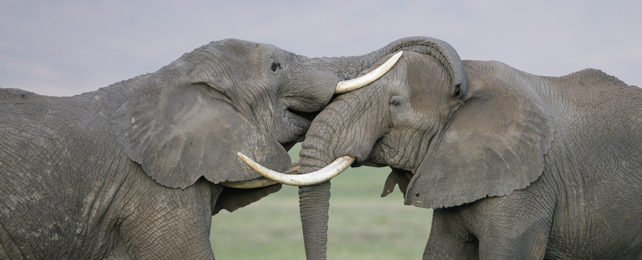Preserving populations of critically endangered forest elephants is crucial not just for the animals themselves, but to protect the carbon-sucking capacities of the environments they live in, a new study demonstrates.
The rainforest of central and west Africa, which is the second largest on Earth, could lose 6 to 9 percent of its atmospheric carbon capturing capacity if elephant communities were wiped out – further accelerating the warming of the planet.
Forest elephants play a crucial role in the carbon cycle, 'thinning out' the rainforest canopy by eating fast growing taller trees that capture less carbon. This creates more space and sunlight for the slower growing trees beneath which capture more carbon from the environment.
"If we lose forest elephants, we will be doing a global disservice to climate change mitigation," says biologist Stephen Blake from Saint Louis University in Missouri.
"The importance of forest elephants for climate mitigation must be taken seriously by policy makers to generate the support needed for elephant conservation. The role of forest elephants in our global environment is too important to ignore."
Using data from previous studies and new information collected in the field, the team analyzed nearly 200,000 records of forest elephant feeding patterns in Africa, covering more than 800 individual plant species.
The preference that elephants have for the lower carbon density trees seems to be down to the nutritional value they get from them rather than they've availability: they're more palatable to the animals and easier to digest.
In terms of fruit though, the elephants prefer higher carbon density trees, which have fruit that is bigger and sweeter. This means that the elephants also help to distribute seeds for these carbon-heavy trees further around the forest. Some tree species can't even survive without the help of these animals.
"Elephants eat lots of leaves from lots of trees, and they do a lot of damage when they eat," says Blake.
"They'll strip leaves from trees, rip off a whole branch or uproot a sapling when eating, and our data shows most of this damage occurs to low carbon density trees.
"If there are a lot of high carbon density trees around, that's one less competitor, eliminated by the elephants."
There are thought to be less than 500,000 African elephants in the wild now, down from 3-5 million during the last century. Ivory hunting accounts for this drastic reduction, with 80 percent of herds lost in some areas. Habitat loss and human-elephant conflict are reducing population numbers even further.
This new study emphasizes the importance of protecting these African elephants, the largest animals walking on Earth. They are one of 9 species of megaherbivores – terrestrial plant eaters with a body mass greater than 1,000 kilograms or 2,200 pounds.
There are now far fewer megaherbivores than there used to be, and tropical forests are suffering as a result, the researchers say. Future studies are now planned looking at other regions and other species, to see how other large herbivores such as the Asian elephant and primates could affect rainforest health.
"Elephants are the gardeners of the forest," says Blake.
"They plant the forest with high carbon density trees and they get rid of the weeds which are the low carbon density trees. They do a tremendous amount of work maintaining the diversity of the forest."
The research has been published in PNAS.
